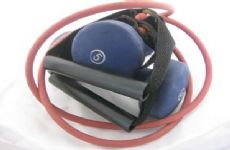|
A heart rate monitor (HRM) is capable of estimating calorie burn pretty accurately—but only for aerobic (cardio) exercise, not for strength training. Here's why: A HRM won't give you an accurate idea of how many calories you burn during strength training because the relationship between heart rate and calorie expenditure is not the same during strength training as during cardio exercise, which is what the HRM's estimate is based on. Unless your weight training is very vigorous circuit training, the heart rate monitor will be overestimating your calorie burn by a fair amount. The problem is a technical one. Calorie burning isn't determined by heart rate; it's determined by the number of muscle cells that are activated to perform a given activity. It's the working cells that actually use the energy (calories) and consume oxygen. When working muscle cells need more energy and oxygen, your heart rate goes up to deliver these things to the cells via the blood stream. Any muscle that performs a high intensity or maximum effort (strength training) will trigger an increase in heart rate and blood flow. But if only a single muscle group is on the receiving end to utilize that extra oxygen (doing a strength exercise that isolates your biceps, for example), only a relatively small amount of oxygen (and calories) will actually be consumed. So while a series of strength training exercises may elevate your heart rate like aerobic exercise does, you're not actually using as much oxygen and burning as many calories as you would be if you were steadily using several large muscles all at once, as when walking, running, swimming, or doing aerobics for example. The heart rate monitor doesn’t know whether your increase in heart rate is due to several large muscle groups working (cardio), an isolated muscle group lifting a weight (strength training), or even if adrenaline or excitement is increasing your heart rate. It just knows your heart rate, and the formulas it uses to estimate calories are based on studies of aerobic exercise, not other activities. So, it's going to overestimate your calorie expenditure when the rise in heart rate is stimulated by using isolated muscles at maximum intensity, which is what occurs during strength training. |
Related Entries
More From SparkPeople
|


.jpg)
.jpg)

.png)

















